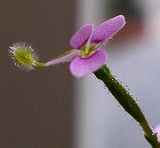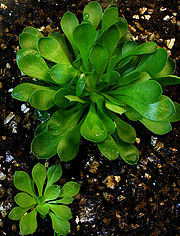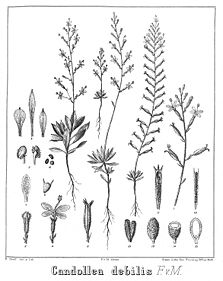
Stylidium debile
Encyclopedia
Stylidium debile, commonly known as the frail triggerplant, is a carnivorous
, dicotyledon
ous plant
that belongs to the genus
Stylidium (family Stylidiaceae
). S. debile is endemic to coastal areas in Queensland
and New South Wales
, Australia
.
 Stylidium debile is an herbaceous annual plant
Stylidium debile is an herbaceous annual plant
that grows from 15 to 30 cm tall. Oblanceolate
or obovate leaves, about 20-200 per plant, form a basal rosette
with stems
absent or present. The leaves are generally 8-30 mm long and 3-7 mm wide. This species produces 1-2 scapes
per plant that are glabrous. Inflorescence
s are 10-25 cm long and produce pink flowers that bloom year-round in their native range. S. debiles historical distribution included a range on the Atherton Tableland
, at Mt Playfair near Tambo, Queensland
, and as far south as Alexandria Swamps in Sydney
, though it is probably extinct in these locations due to extensive habitat modification. More recent herbarium
collections relate a distribution from Blackdown Tableland and Deepwater National Park
in Queensland
south to the area around Coffs Harbour in New South Wales
. Its typical habitat has been reported as sandy or pale silty clay soils on creekbanks or in swampy areas. Dominant vegetation in association with its habitat include Melaleuca quinquenervia
and Lophostemon suaveolens. S. debile is most closely related to S. paniculatum
but differs by the inflorescence form and the presence of bract
s. Its conservation status
has been assessed as secure.
 The infraspecific taxonomy of this species formerly listed two varieties:
The infraspecific taxonomy of this species formerly listed two varieties:
Joseph Maiden
and Ernst Betche described the differences between the two varieties in a 1905 publication. In 1999, Tony Bean elevated S. debile var. paniculatum to the species level, giving it the name Stylidium paniculatum
(Maiden & Betche) A.R.Bean, thus rendering the autonym
var. debile unnecessary.
by division of the vegetative clones that arise from the root system. And though in its native range it may be considered an annual, in cultivation it is mostly a perennial
.
Carnivorous plant
Carnivorous plants are plants that derive some or most of their nutrients from trapping and consuming animals or protozoans, typically insects and other arthropods. Carnivorous plants appear adapted to grow in places where the soil is thin or poor in nutrients, especially nitrogen, such as acidic...
, dicotyledon
Dicotyledon
The dicotyledons, also known as dicots, are a group of flowering plants whose seed typically has two embryonic leaves or cotyledons. There are around 199,350 species within this group...
ous plant
Plant
Plants are living organisms belonging to the kingdom Plantae. Precise definitions of the kingdom vary, but as the term is used here, plants include familiar organisms such as trees, flowers, herbs, bushes, grasses, vines, ferns, mosses, and green algae. The group is also called green plants or...
that belongs to the genus
Genus
In biology, a genus is a low-level taxonomic rank used in the biological classification of living and fossil organisms, which is an example of definition by genus and differentia...
Stylidium (family Stylidiaceae
Stylidiaceae
The family Stylidiaceae is a taxon of dicotyledonous flowering plants. It consists of five genera with over 240 species, most of which are endemic to Australia and New Zealand. Members of Stylidiaceae are typically grass-like herbs or small shrubs and can be perennials or annuals...
). S. debile is endemic to coastal areas in Queensland
Queensland
Queensland is a state of Australia, occupying the north-eastern section of the mainland continent. It is bordered by the Northern Territory, South Australia and New South Wales to the west, south-west and south respectively. To the east, Queensland is bordered by the Coral Sea and Pacific Ocean...
and New South Wales
New South Wales
New South Wales is a state of :Australia, located in the east of the country. It is bordered by Queensland, Victoria and South Australia to the north, south and west respectively. To the east, the state is bordered by the Tasman Sea, which forms part of the Pacific Ocean. New South Wales...
, Australia
Australia
Australia , officially the Commonwealth of Australia, is a country in the Southern Hemisphere comprising the mainland of the Australian continent, the island of Tasmania, and numerous smaller islands in the Indian and Pacific Oceans. It is the world's sixth-largest country by total area...
.
Characteristics

Annual plant
An annual plant is a plant that usually germinates, flowers, and dies in a year or season. True annuals will only live longer than a year if they are prevented from setting seed...
that grows from 15 to 30 cm tall. Oblanceolate
Leaf shape
In botany, leaf shape is characterised with the following terms :* Acicular : Slender and pointed, needle-like* Acuminate : Tapering to a long point...
or obovate leaves, about 20-200 per plant, form a basal rosette
Rosette (botany)
In botany, a rosette is a circular arrangement of leaves, with all the leaves at a single height.Though rosettes usually sit near the soil, their structure is an example of a modified stem.-Function:...
with stems
Plant stem
A stem is one of two main structural axes of a vascular plant. The stem is normally divided into nodes and internodes, the nodes hold buds which grow into one or more leaves, inflorescence , conifer cones, roots, other stems etc. The internodes distance one node from another...
absent or present. The leaves are generally 8-30 mm long and 3-7 mm wide. This species produces 1-2 scapes
Scape (botany)
In botany, scapes are leafless flowering stems that rise from the ground. Scapes can have a single flower or many flowers, depending on the species....
per plant that are glabrous. Inflorescence
Inflorescence
An inflorescence is a group or cluster of flowers arranged on a stem that is composed of a main branch or a complicated arrangement of branches. Strictly, it is the part of the shoot of seed plants where flowers are formed and which is accordingly modified...
s are 10-25 cm long and produce pink flowers that bloom year-round in their native range. S. debiles historical distribution included a range on the Atherton Tableland
Atherton Tableland
The Atherton Tableland is a fertile plateau which is part of the Great Dividing Range in Queensland, Australia. It is located west to south-south-west inland from Cairns, well into the tropics, but its elevated position provides a climate suitable for dairy farming. It has an area of around...
, at Mt Playfair near Tambo, Queensland
Tambo, Queensland
Tambo is a town located in central western Queensland, Australia, on the banks of the Barcoo River. Tambo is southeast of the town of Blackall via the Landsborough Highway, and approximately north west of the state capital, Brisbane. At the 2006 census, Tambo had a population of 345.The town was...
, and as far south as Alexandria Swamps in Sydney
Sydney
Sydney is the most populous city in Australia and the state capital of New South Wales. Sydney is located on Australia's south-east coast of the Tasman Sea. As of June 2010, the greater metropolitan area had an approximate population of 4.6 million people...
, though it is probably extinct in these locations due to extensive habitat modification. More recent herbarium
Herbarium
In botany, a herbarium – sometimes known by the Anglicized term herbar – is a collection of preserved plant specimens. These specimens may be whole plants or plant parts: these will usually be in a dried form, mounted on a sheet, but depending upon the material may also be kept in...
collections relate a distribution from Blackdown Tableland and Deepwater National Park
Deepwater National Park
Deepwater is a coastal national park in Queensland, Australia, 375 km north of Brisbane. It protects an area of sand dunes and coastal heaths in the Deepwater Creek catchment. The area is one of the few remaining pristine freshwater catchments on Queensland's east coast...
in Queensland
Queensland
Queensland is a state of Australia, occupying the north-eastern section of the mainland continent. It is bordered by the Northern Territory, South Australia and New South Wales to the west, south-west and south respectively. To the east, Queensland is bordered by the Coral Sea and Pacific Ocean...
south to the area around Coffs Harbour in New South Wales
New South Wales
New South Wales is a state of :Australia, located in the east of the country. It is bordered by Queensland, Victoria and South Australia to the north, south and west respectively. To the east, the state is bordered by the Tasman Sea, which forms part of the Pacific Ocean. New South Wales...
. Its typical habitat has been reported as sandy or pale silty clay soils on creekbanks or in swampy areas. Dominant vegetation in association with its habitat include Melaleuca quinquenervia
Melaleuca quinquenervia
Melaleuca quinquenervia, commonly known as Niaouli or Broad-leaved paperbark or the Paper Bark Tea Tree, is a small- to medium-sized tree of the allspice family, Myrtaceae. The plant is native to New Caledonia, Papua New Guinea and coastal Eastern Australia, from Botany Bay in New South Wales...
and Lophostemon suaveolens. S. debile is most closely related to S. paniculatum
Stylidium paniculatum
Stylidium paniculatum is a dicotyledonous plant that belongs to the genus Stylidium . It is an herbaceous annual that grows from 10 to 35 cm tall. Oblanceolate or obovate leaves, about 6-30 per plant, form either a basal rosette with stems absent or in terminal rosettes when plant stems are...
but differs by the inflorescence form and the presence of bract
Bract
In botany, a bract is a modified or specialized leaf, especially one associated with a reproductive structure such as a flower, inflorescence axis, or cone scale. Bracts are often different from foliage leaves. They may be smaller, larger, or of a different color, shape, or texture...
s. Its conservation status
Conservation status
The conservation status of a group of organisms indicates whether the group is still extant and how likely the group is to become extinct in the near future...
has been assessed as secure.
Taxonomy

- Stylidium debile var. debile Maiden & Betche
- Stylidium debile var. paniculatum Maiden & Betche
Joseph Maiden
Joseph Maiden
Joseph Henry Maiden was a botanist who made a major contribution to knowledge of the Australian flora, especially the Eucalyptus genus. This botanist is denoted by the author abbreviation Maiden when citing a botanical name.Joseph Maiden was born in St John's Wood, London...
and Ernst Betche described the differences between the two varieties in a 1905 publication. In 1999, Tony Bean elevated S. debile var. paniculatum to the species level, giving it the name Stylidium paniculatum
Stylidium paniculatum
Stylidium paniculatum is a dicotyledonous plant that belongs to the genus Stylidium . It is an herbaceous annual that grows from 10 to 35 cm tall. Oblanceolate or obovate leaves, about 6-30 per plant, form either a basal rosette with stems absent or in terminal rosettes when plant stems are...
(Maiden & Betche) A.R.Bean, thus rendering the autonym
Autonym (botany)
In botanical nomenclature, autonyms are automatically created names, as regulated by the International Code of Botanical Nomenclature . Autonyms are cited without an author. Relevant provisions are in articles 6.8, 22.1-3 and 26.1-3....
var. debile unnecessary.
Cultivation
This coastal species is one of the relative few Stylidium species that is available in cultivation and is grown in similar conditions to tropical Australian Drosera. It is propagatedPlant propagation
Plant propagation is the process of creating new plants from a variety of sources: seeds, cuttings, bulbs and other plant parts. Plant propagation can also refer to the artificial or natural dispersal of plants.-Sexual propagation :...
by division of the vegetative clones that arise from the root system. And though in its native range it may be considered an annual, in cultivation it is mostly a perennial
Perennial plant
A perennial plant or simply perennial is a plant that lives for more than two years. The term is often used to differentiate a plant from shorter lived annuals and biennials. The term is sometimes misused by commercial gardeners or horticulturalists to describe only herbaceous perennials...
.

